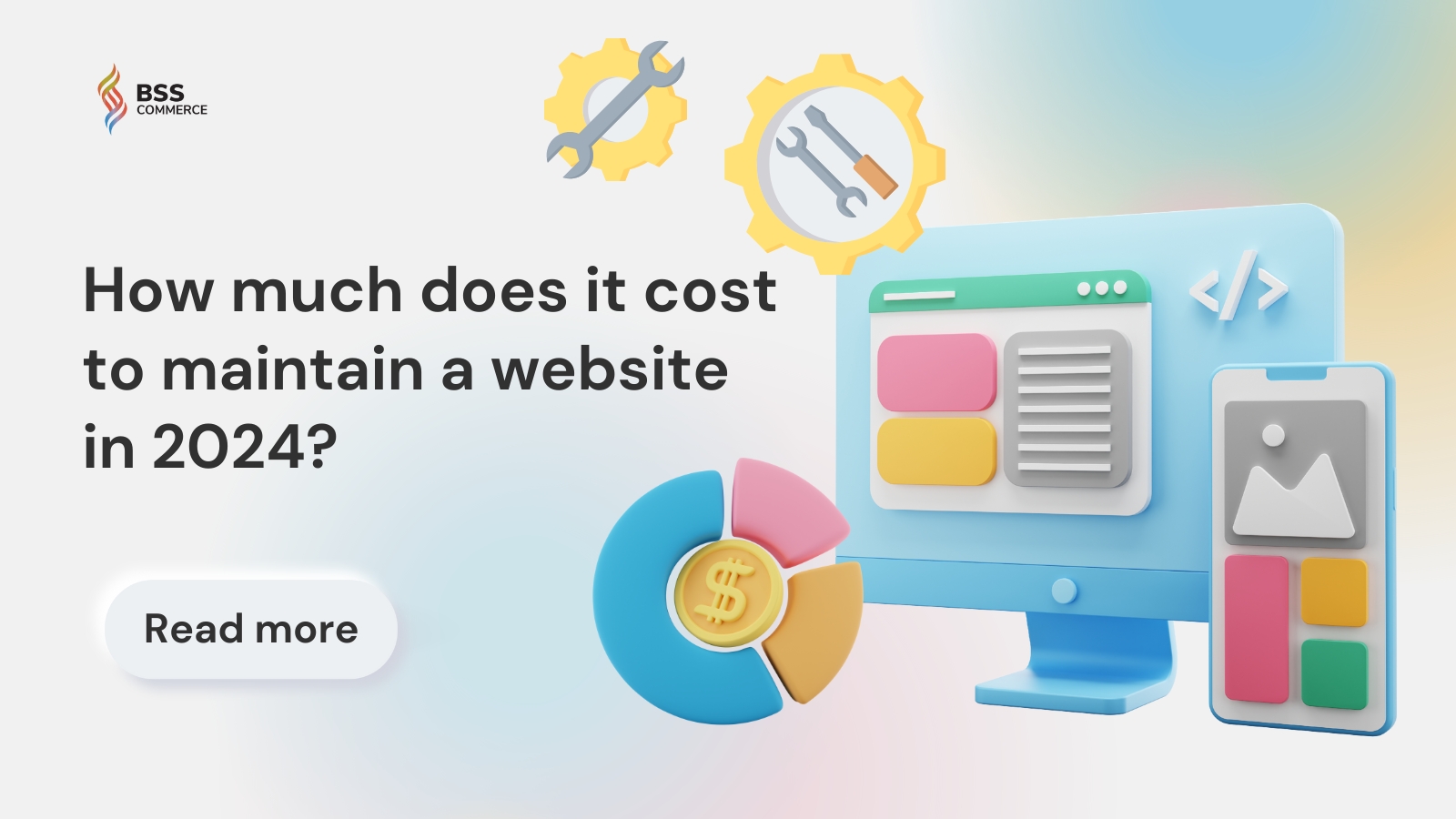Have you ever wondered “How much does it cost to maintain a website?” While the cost to build a website can vary, you can make a rough guess about your expenses by thinking about where you’ll need to put your money. If you want solid figures on the cost of website maintenance, read on for a breakdown of website maintenance costs.
Contents
How much does it cost to maintain a website? – 9 Essential Costs To Maintain A Website
Domain Name
- Average costs: about $1 – 100/year to register and $10 – 129/year to renew
- Level of necessity: necessary

How much does it cost to maintain a website? First, every website needs a domain, and you’ll pay between $10 – 129/year to renew it. Some hosting providers give you a free domain when you sign up for their hosting plans, which saves you money.
Besides, the price of a domain name depends on what extension it has. The three most common extensions or top-level domains (TLDs) are:
- Generic top-level domain (gTLD) – any website can use a gTLD, like .com, .net, and .org. The cost changes based on how popular it is.
- Country code top-level domain (ccTLD) – extensions for websites specific to countries, like .us for the United States or .jp for Japan.
- Sponsored top-level domain (sTLD) – extensions for websites with specific owners or purposes, like .edu for educational institutions.
Additionally, the registrar is another factor affecting a domain name’s website maintenance costs. Picking a trustworthy domain registrar is key to steer clear of scams and surprise fees. To find a trustworthy registrar, you should check ICANN’s accredited registrar list. In most cases, buying a domain name means to register it for at least one year. The website owner needs to renew the domain name before it expires to keep using it.
Web Hosting

- Average costs: about $10 – 200/month, based on the web hosting provider, type, and subscription length
- Level of necessity: necessary
Web hosting allows you to put a website on the internet. How much it costs depends on the company you choose and the plan you pick. Picking the right hosting company plays a big role in how much your website will cost to keep up. Different hosting companies often charge different prices for plans that look similar.
Before you decide on a hosting plan, think about how much it’ll cost in the long run. The total amount you’ll spend on hosting comes down to how long you sign up for. If you pay month by month, you’ll end up spending more overall.
Here are some of the most common types of web hosting you can get:
- Shared host: A shared host costs $2 – 15/month. It’s the cheapest option because it puts your website on a server with other sites. If your website doesn’t get much traffic, a shared host service can do the job.
- Website builder: A website builder hosting service, like from Wix or WordPress, has a cost of $3 – 70/month. This service option gives a great answer for small businesses and professional bloggers.
- Virtual private server (VPS): A VPS has a price tag of $20 – 100/month. You share your server, like with shared hosting, but you have full control over your server’s resources because the provider splits the server into several virtual servers. Think of a VPS as an apartment building where the server is the building and the virtual servers are the apartments.
- Cloud hosting: This option to host websites ranges from $10 – 200/month. Cloud hosting, as the name hints at, means your website lives on virtual servers in the cloud. It’s a smart choice for companies that see heavy traffic but don’t want to shell out for a dedicated server.
- Dedicated server: A dedicated server has a cost range of $80 – 500/per month. It stands as the priciest choice for website hosting, which explains why most websites using a dedicated server see over 100,000 monthly visitors. With this option, you get full control over your own server.
Your company might want to cut costs by picking a cheaper hosting option. However, it’s crucial to choose the best fit for your website. If you go for a hosting plan that can’t handle your current traffic levels, your site might slow down and you could miss out on valuable leads.
>>> You may concern: Shopify vs Own Website – Which Is More Optimized Solution for Ecommerce
SSL Certificate

- Average costs: $0 – 60/year
- Level of necessity: necessary
Secure Sockets Layer (SSL) has an impact on data transfer. It enables encrypted communication between a server and a browser.
Having an SSL certificate brings several advantages. These include better security, stronger data privacy, and improved performance on search engines. Websites that handle sensitive user information should use SSL certificates. This applies to sites dealing with passwords or credit card details.
The price of SSL certificates can change based on how many domains or subdomains they cover. A single-domain SSL’s cost ranges from $7 – 860/year. A wildcard SSL certificate, which protects multiple subdomains, has a price between $50 – 1,000/year. To cut costs, you can opt for a web hosting plan that includes a free SSL certificate.
Email Services

- Average costs: $1 – 6/user/month
- Level of necessity: important
Custom email hosting allows website owners to create unique email addresses using their domain names, like username@yourdomain.com. Also, a personalized email helps companies boost their brand, show professionalism, and build trust with customers. Google Workspace provides a well-known premium email service for $6 per month for each mailbox. Another choice is to find a hosting provider that includes free email services with their hosting plans.
Besides, the number of mailboxes has an impact on the upkeep costs of email services. Buying more mailboxes will increase the overall cost.
Tech Support

- Average costs: $2 – 300/month
- Level of necessity: important
Having a customer service team to turn to can help when things go wrong, like when websites crash, contact forms break, or security gets compromised. No matter if you’re new to this or have lots of experience, good tech support can solve problems before they hurt your traffic and how customers feel about your site.
You can get tech support in a few ways:
- Live chat – gives you quick help through chat messages.
- Email ticketing system – uses email and an online system to track requests for tech help. This works well if you want to keep a record of your talks with customer service.
- Phone service – lets you talk to someone in customer service to get answers.
- Knowledge database – takes the shape of tutorials or guides for users who like to fix problems on their own.
Most hosting providers give live chat and email support with every plan. These support options should be enough when running a personal or a small business website. On the other hand dedicated premium support is best for larger websites like online stores. They give quick tailored support.
Also, in most cases, service agreements set time limits for fixing issues. For instance, a basic website maintenance cost package might have a five-business-day fix time while a premium plan offers a two-business-day fix time. You’ll pay more if you want faster fixes.
Before you team up with a provider, check their response times and make sure they fit what your company needs. Getting expert help ensures your website works well. Without tech support, your in-house team has to solve tricky problems, like broken shopping carts fast.
If you have someone in-house to give technical support, you don’t need to worry about extra costs.
All in all, whether you include tech support in your website upkeep costs depends on what you need.
Website Design

- Average costs: $0 – 17/month if you’re self-designing, or $500 – 1,000/year for a regular maintenance package with a web design professional
- Level of necessity: important
Website design shows your brand online. It’s one of the first things visitors see before they decide if your content deserves their time. Good web design helps search engine optimization (SEO) to bring more visitors. Web design prices change based on your choice – doing it yourself or hiring an expert.
- Designing The Website On Your Own
Designing your own website is a great choice for smaller sites such as personal blogs. You have the option to build a website from the ground up using free or paid tools. This approach adds a small monthly cost to your website upkeep about $17/month.
Newcomers looking for more control and adaptability can use a CMS like WordPress to create and shape a website. You’ll need to pick and set up the WordPress site theme on your own. With a WordPress site, you can select from over 10,000 free themes in the official collection. Still, paid WordPress themes offer extra features and better help. Before you buy one, look at the available payment options first. You can purchase some themes with a one-time license cost, while others use a subscription model. Plan to spend about $5–17/month for a high-quality WordPress theme.
If you don’t want to learn WordPress or coding, you should think about using a website builder. These tools offer a bunch of pre-made designs by pros. Most of them let you drag and drop stuff around making it easy to change things up. Some even have AI that can make designs based on what you tell it.
- Hiring A Professional Web Designer
Web designers who are well-versed keep up with current design trends. They can write code to make a website just how you want it. They use things like JavaScript to build unique sites that grab people’s attention. A lot of them also help keep your site running by updating software, fixing problems, and making sure everything works well.
However, bringing a skilled designer on board can really drive up the costs of keeping your website running . Plus, you’ll need to think about signing a yearly upkeep agreement. What you’ll pay a web designer changes based on the kind of site you have, but for a simple project, you’re looking at around $6,000. Keeping the website in good shape can set you back $500 – 1,000/year. Because it’s so pricey, this choice makes more sense for big websites that see a lot of visitors.
>>> Discover 10+ Best Shopify Mobile App Builders
Plugins And Extensions

- Average costs: $5 – 50/month
- Level of necessity: Optional
Plugins make websites work better. Right now, you can find over 59,000 WordPress plugins in the main library. While many are free, the paid ones can increase your website upkeep costs. It’s a good idea to start with free WordPress plugins. As your site grows, you can begin to spend money on paid plugins. The costs for maintaining paid WordPress plugins range from $4 – 49/month.
To help your website run, add these plugins:
- Contact form plugins – offer great ways to manage messages from people visiting your WordPress site. The versions you pay for cost between $24 – 300/year.
- Page builders – add a drag-and-drop interface to your site editor. The average maintenance fee for premium page builders ranges from $20 – 350/year.
- Security plugins – help protect your website with a firewall, malware scanner brute-force protection, and login protection. The premium versions of security plugins have a price range of $50 – 600/year.
So, the specific plugins you pick will have an impact on the actual cost of maintaining your WordPress website. Other platforms, including website builders also offer their own versions of add-ons or plugins. Most of them will have both free and premium options for you to think about.
ECommerce Features

- Average costs: $15/month for regular-sized online stores
- Level of necessity: optional
Online stores cost more to maintain because they need payment systems and ways to track what’s in stock. You can pay even more if you want extras like special help or email ads.
How much a custom online store costs depends on what it needs to do. You might not need a tool to keep track of inventory if you sell things like eBooks or classes that people take online.
Think about these key parts for an online store:
- eCommerce platform – has all the basic things you need to sell online. Many website builders offer plans to help you set up an online store.
- Inventory management – provides tools to handle product stock. A few free and paid inventory management plugins include WP Inventory Manager ($0 – 149/license), Zoho ($0 – 329/month), and Ordoro ($0 – 149/month).
- Payment gateways – provides tools to handle product stock. PayPal’s popular and secure payment gateway Payflow Pro costs $25/month.
Keep in mind that eCommerce feature prices change based on your online store’s size and traffic. For a typical website just starting to sell products or services, eCommerce features cost about $15/month. As you sell more products and services, the cost goes up.
Marketing and SEO

- Average costs: $0 – 500/month
- Level of necessity: important
You need to budget for marketing and SEO strategies to attract visitors to a website. This involves publishing fresh high-quality content such as articles, videos, and photos to draw in your target audience. When planning your website maintenance cost, think about these digital marketing approaches to boost your brand:
- Website optimization – boost your website’s position on search engine results pages (SERP). Some top-notch SEO tools come with a price tag: Ahrefs ($99-999/month), Ubersuggest ($29-99/month), and Moz ($99-599/month).
- Content marketing – make content that’s relevant and on-trend to draw in, hook, and keep audiences. You can create content in-house or hire digital marketing agencies or freelancers to do it. Prices change based on the type of content, but you should plan to pay $1/word for an article or $50-3,000/project.
- Email marketing – let your audiences know what’s going on with your business. Mailchimp ($0-1,510/month) and Constant Contact ($9.99-300/month) are two of the most-used email marketing tools. If you use WordPress, you can also find free email newsletter plugins.
- Social media marketing – reach a wider audience. Companies spend $6,000 – 10,500/month on digital marketing tools, ads, and someone to manage their social media.
You don’t need to start all these marketing strategies right away. Smaller websites can begin with basic SEO, email, and content marketing tactics.
To wrap up, your company’s website management costs depend on your specific website. This is why breaking down website maintenance cost by website type such as ecommerce small business, or enterprise, can be helpful. You can estimate your website maintenance costs using the table below:
| Website Type | Monthly Website Maintenance Cost |
| Personal Websites | $5 – 25/month |
| Professional Blogs | $25 – 75/month |
| Small to Medium Business Websites | $35 – 500/month |
| SMB Business Website | $125 to $500 /month |
| Corporate Websites | $200 – 4,500/month |
| Multimedia Entertainment Websites | $300 – 2,500/month |
| Custom Business Website | $350 to $4500 /month |
| ECommerce Websites | $750 – 5,000/month |
| Custom Ecommerce Website | $2000 to $5000 /month |
Tips To Reduce Costs To Maintain A Website

You can take several steps to cut down on website maintenance costs. Here are some things to think about to reduce your maintenance expenses:
- Picking reliable and cheap hosting can cut down on web upkeep costs.
- Keep software up to date to stop security issues and lower the need for big fixes.
- Set up automatic routines for updates, backups, and security checks to save time.
- Use fewer plugins to make troubleshooting and updating the site easier.
- Skip maintenance tasks that don’t fix any actual problems.
- Think about using a plan to schedule, track, and check all your tech work ahead of time.
- Find out why your site goes down and fix it once instead of patching it over and over and wasting money.
- Don’t spend on fixing your website when it breaks – it wastes time, money, and resources.
- Get to know your assets’ lifecycle to understand how often they need fixing.
- Save cash on license fees and cut down on custom coding by using open-source programs.
- Put money into a pro website upkeep service.
Also, website builders offer a cheaper and easier way to create and maintain your own website. While a DIY website often needs a lot of hands-on upkeep, a website builder can cut your costs by providing the tools, support and know-how to keep your site in good shape.
Bottom Up
By now, you have a better idea of “How much does it cost to maintain a website?”, and it’s time to plan a budget. Keeping your website in good condition is key to keep it up & running. Skipping website maintenance can make your site weak, which can lead to data loss. It can also cause slow load times, poor performance & low search rankings.
CONTACT NOW to let us know your problems. We are willing to support you every time.




